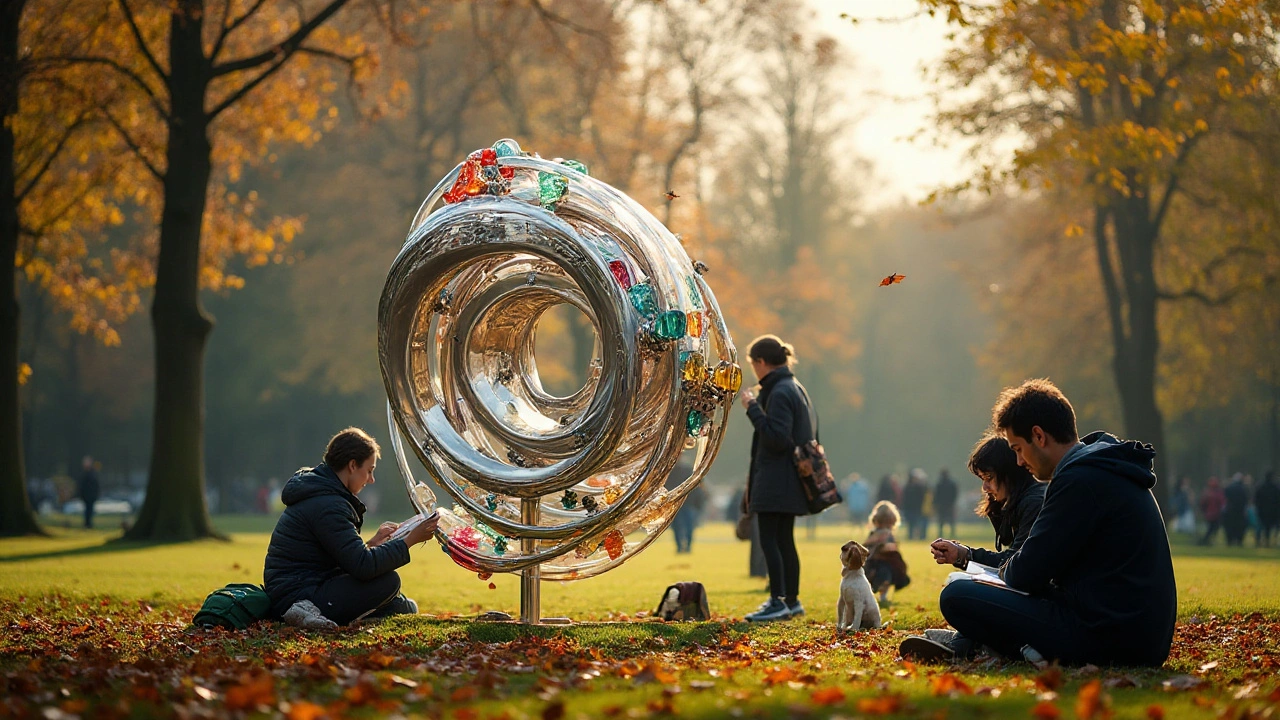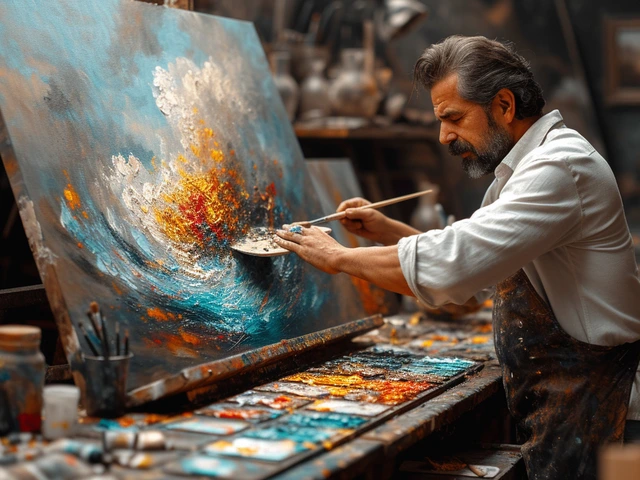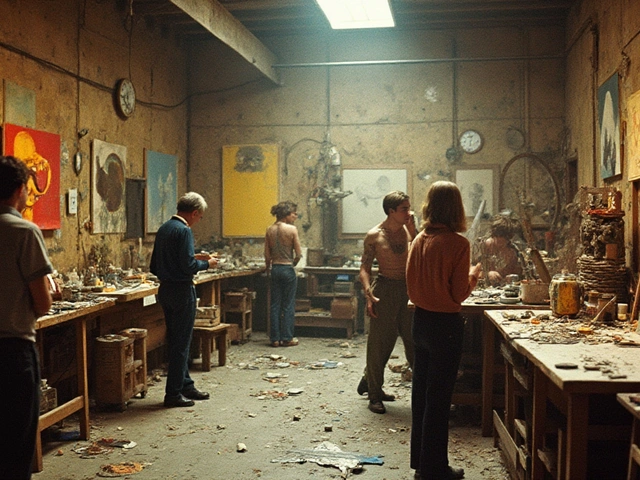Kinetic art is where motion and creativity collide. It's a form of art that uses movement as an integral part of the design, captivating viewers and inviting them to see traditional art in a new light. By incorporating elements that can move independently, kinetic sculptures challenge the static nature of conventional art pieces and breathe life into artistic expression.
This art form doesn't just appeal to our visual senses—it sparks curiosity and wonder, making each piece a dynamic experience rather than a static observation. From the subtle sway of a mobile to the intricate gears of a kinetic sculpture, this art inspires both artists and onlookers to ponder the beauty found in movement and change.
- The Origins of Kinetic Art
- Key Elements and Materials Used
- Influential Artists and Their Impact
- Understanding Motion and Balance
- Tips for Creating Your Own Kinetic Art
The Origins of Kinetic Art
The fascinating journey of kinetic art begins in the early 20th century, a time bursting with innovation, experimentation, and the relentless pursuit of new forms of artistic expression. Artists sought to break free from the confinements of traditional art and infuse their works with a sense of dynamism and life. The concept of incorporating motion into art, which became the hallmark of kinetic works, was revolutionary. This notion paralleled the industrial and technological advancements of the era, with the machine age inspiring both artists and engineers alike.
Marcel Duchamp, one of the early pioneers, was instrumental in laying the groundwork for kinetic art with his 1913 piece, the "Bicycle Wheel." By adding a bicycle wheel to a stool, Duchamp created one of the first mobiles in art history—though it didn't physically move to its full potential, it set a philosophical precedent for what art could be. This was a radical departure from static sculptures and challenged the perceptions of art as solely a visual medium.
The term "kinetic art" was more formally introduced in the 1920s and 1930s, notably by Russian Constructivists who embraced movement as a reflection of the social and technological changes sweeping through society. Artists such as Naum Gabo and Laszlo Moholy-Nagy embraced this new vision with works that combined artistic technique and engineering. Their contributions demonstrated how movement could serve as a new language in art, shifting the focus from mere representation to experience.
"Art and technology, a new unity," said Moholy-Nagy, encapsulating the spirit of the era where artists and innovators found common ground.
As the 20th century progressed, kinetic art saw an array of developments spurred by technological advancements and new materials. In the 1950s, artists like Alexander Calder further expanded the genre with his masterful mobiles, which danced gracefully with airflow, shifting the boundaries yet again. Calder’s mobiles were masterworks, not just for their aesthetic appeal but for their integration of natural forces such as gravity and the perpetual dance with wind currents, creating a living theater of form and motion.
Throughout time, the tenets of kinetic art developed alongside global events and technological advances, creating a continually evolving art form. It resonated across the world, with movements and artists in Europe, the Americas, and beyond contributing their unique interpretations to the art of movement.
Sculpture found new life as these creative minds introduced elements such as electric motors, magnets, and even participant engagement to bring pieces to life. This art form blurred the line between engineering and artistry, creating a hybrid discipline that defied categorization, much like the world of art itself—dynamic, never static, and always evolving.
Key Elements and Materials Used
In the enchanting world of kinetic art, the choice of elements and materials forms the backbone of every stirring creation. At its core, it's about creating movement—motion that aims to engage and sometimes even mesmerize onlookers. Artists typically employ a mix of scientific ingenuity and artistic vision to bring their sculptures to life. The materials used are not merely functional; they are chosen for their ability to catch light, create sound, and produce an interactive play of shadows, adding layers of depth to an already tactile experience. Glass, metal, wood, and plastic often serve as the primary materials, each bringing its own unique qualities to the piece. Metals like stainless steel or aluminum are favored for their durability and luster. They allow artists to create the fine structures needed to achieve intricate movements while maintaining the desired aesthetic appeal.
Balance is another critical aspect, as it dictates how smoothly and consistently the piece will move. This is where physics marries art. A keen understanding of center of gravity and equilibrium can make or break the illusion of effortless motion. Sculptors often incorporate bearings, pivot points, and counterweights to ensure fluidity in the sculpture's movement. According to renowned kinetic artist Alexander Calder, "Just as one can compose colors, or forms, so one can compose motions." The idea is not just to make things move but to create a choreographed dance that accentuates the harmony of design and functionality.
Incorporating technology further elevates the dynamic capabilities of kinetic sculptures. Microcontrollers, sensors, and small motors are becoming increasingly common, allowing for even greater control over movement. This gives the artist the ability to manipulate the sculpture in response to external stimuli, such as light, sound, or proximity. For example, a sculpture might sway gently in response to the viewer's presence, creating an intimate dialogue between art and observer. As interactive elements become more accessible, we see an exciting fusion of digital and physical realms where art is no longer just observed; it is experienced.
Traditional as well as innovative materials and tools provide artists an endless palette from which to draw. But creativity doesn’t just lie in the type of materials; it's also found in how these materials interact. Modern kinetic artists often experiment with composites, combining different materials to harness their distinct properties. This practice not only broadens the range of tactile and visual effects achievable but also challenges the very notions of how art should be constructed. This blend of old and new, observation and interaction, makes the field both demanding and rewarding for those willing to explore its limitless possibilities.
Another angle to consider in kinetic art is the incorporation of natural elements. Wind, water, and even the human touch are often designed to play interactive roles. Kinetic wind sculptures, for instance, harness natural breezes to rotate or pivot, providing a striking display that feels like a collaboration with nature itself. Fire and water can also serve as dynamic elements that interact with sculptures, adding layers of meaning and environmental sensitivity to the work. There exists an inherent spontaneity in relying on nature, offering unpredictable yet inspiring results that can uniquely transform the viewing experience.
Every piece of kinetic art tells a story not just through its components, but also through the very act of moving. These are sculptures that act, react, and are often designed to physically change with the environment, season, or even time period. The artist thus not only presents a finished work but invites the audience into a shared moment of transformation, emphasizing why the blend of materials and elements is both a science and an art. It’s this beautiful complexity that lives at the heart of kinetic art, a testament to the human capacity for endless innovation and expression through motion.
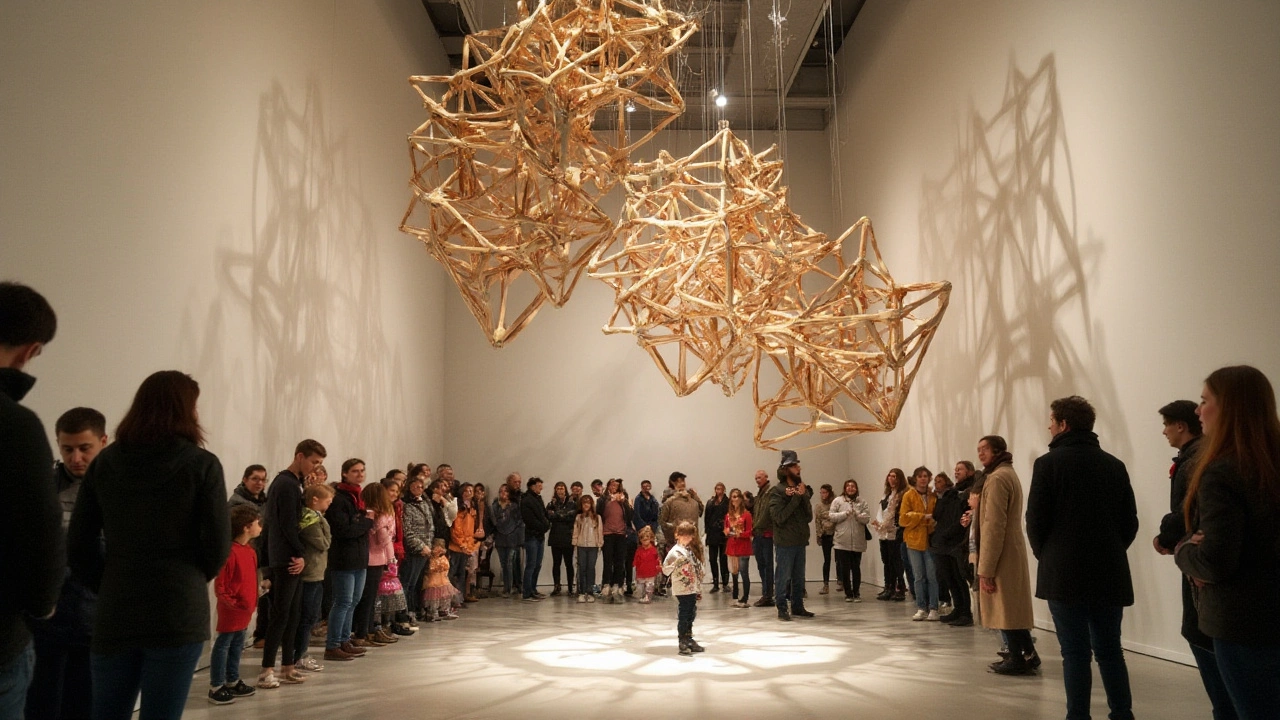
Influential Artists and Their Impact
The world of kinetic art has seen an array of talented artists who have pushed boundaries and challenged perceptions with their innovative use of movement. Among the most influential figures is Alexander Calder, widely revered as a pioneer for his invention of the mobile in the early 20th century. His kinetic sculptures, first introduced through a series of wire circus figures, grew to become complex compositions of delicately balanced elements that seemed to defy gravity. Calder’s work, often characterized by its playful forms and vibrant colors, engages audiences with its dynamic motion, bridging the gap between art and viewer interaction.
Jean Tinguely, another notable name, took kinetic art into the realm of chaos with his mechanically complex sculptures that thrived on unpredictability. His most famous piece, "Homage to New York," was a self-destructing machine that captured the volatile spirit of post-war art. Tinguely’s creations were not just about the aesthetic of movement but tapped into the philosophical, questioning the role of technology in society. He believed that art should be an evolving process rather than a static product, a sentiment that resonated with contemporary thoughts on impermanence and change.
"The process of art is in the interplay of motion and emotion." - Jean Tinguely
Naum Gabo, a visionary within the Constructivist movement, contributed significantly to the evolution of kinetic sculptures through his exploration of space and time. Gabo's work often used transparency and light to create illusions of form, emphasizing volume without mass. His explorations of spatial dynamics provided a foundation for future artists to explore how movement can extend beyond mere mechanics, shaping the essence of kinetic art to be more immersive and multi-dimensional.
Ingrid Schreiber, a more contemporary figure, has embraced modern technology to deepen the interactivity of kinetic installations, incorporating elements such as sensors and computer programs to respond to environmental changes. Her work often involves audience participation, inviting viewers to become part of the artwork’s dynamic evolution. Schreiber’s approach highlights a shift towards art that not only moves physically but also emotionally and intellectually engages its audience.
The impact of these artists is not just seen in the galleries and museums but can also be recognized in the broader cultural conversations about the role of chaos, unpredictability, and viewer interaction in contemporary art. Their legacy is evident in the way kinetic art continuously challenges artists to innovate and audience members to engage more deeply with art, making it a living dialogue between creator, creation, and observer.
Understanding Motion and Balance
The art of kinetic art revolves around the principles of motion and balance, which are integral to the creation and functionality of these captivating works. At the heart of this discipline, the concept of motion invites both natural and mechanical movement into the creative process. These elements can include anything from the subtleties of wind moving a mobile, to the intricate motorized mechanics of a sculpture that captures attention in its delicate interplay of forces. Essentially, the inclusion of motion reflects the dynamic intent of the artist, providing an additional dimension beyond mere visual appearance.
To achieve meaningful motion, balancing the components is key, both literally and metaphorically. The concept of balance in kinetic sculpture often invokes a harmony between chaos and order. Artists meticulously design their pieces to pivot, oscillate, or spin with a calculated equilibrium. Balance is not just physical but visual as well, affecting how the viewer perceives harmony or tension within the piece. This intricate dance of forces requires the artist to have a deep understanding of physics and engineering principles, blending them seamlessly with artistic intuition. An artist might say it’s like composing music; every part must be precise, akin to notes on a sheet.
Many renowned artists have explored the complexities of motion and balance. Alexander Calder, often credited as the father of mobile art, explored these very ideas by creating pieces where balance was both physically evident and metaphorically suggested. Calder once remarked, "To most people who look at a mobile, there’s more in it than meets the eye, but the form alone, even at its simplest, often holds the eye."
Calder’s work demonstrates that there’s more than mechanics at play; there’s a deeper message about the balance within nature and art itself.
For the aspiring kinetic artist, understanding these principles is foundational. It begins with experimenting with different materials and developing a keen sense of how each interacts with external forces. Metals, plastics, and wood each have particular weights and flexibility, affecting motion in distinct ways. Successful kinetic artists often sketch and model multiple iterations, testing the delicacies of balance to ensure that their vision translates into a tangible outcome. In essence, the study of balance in kinetic art is an exploration of both physical properties and the delicate art of storytelling through motion.
Often, kinetic sculptures will employ a wide range of techniques to achieve the desired motion. A common method includes using bearings or counterweights to provide smooth rotational movement. Some artists prefer using tension created by springs or flexible materials to generate a more fluid motion. It's the intricate designs, where balance is often maintained by opposing forces, that exhibit the ingenuity behind this art form. Each element is carefully measured and crafted to play its part, creating a symphony of movement that resonates with spectators.
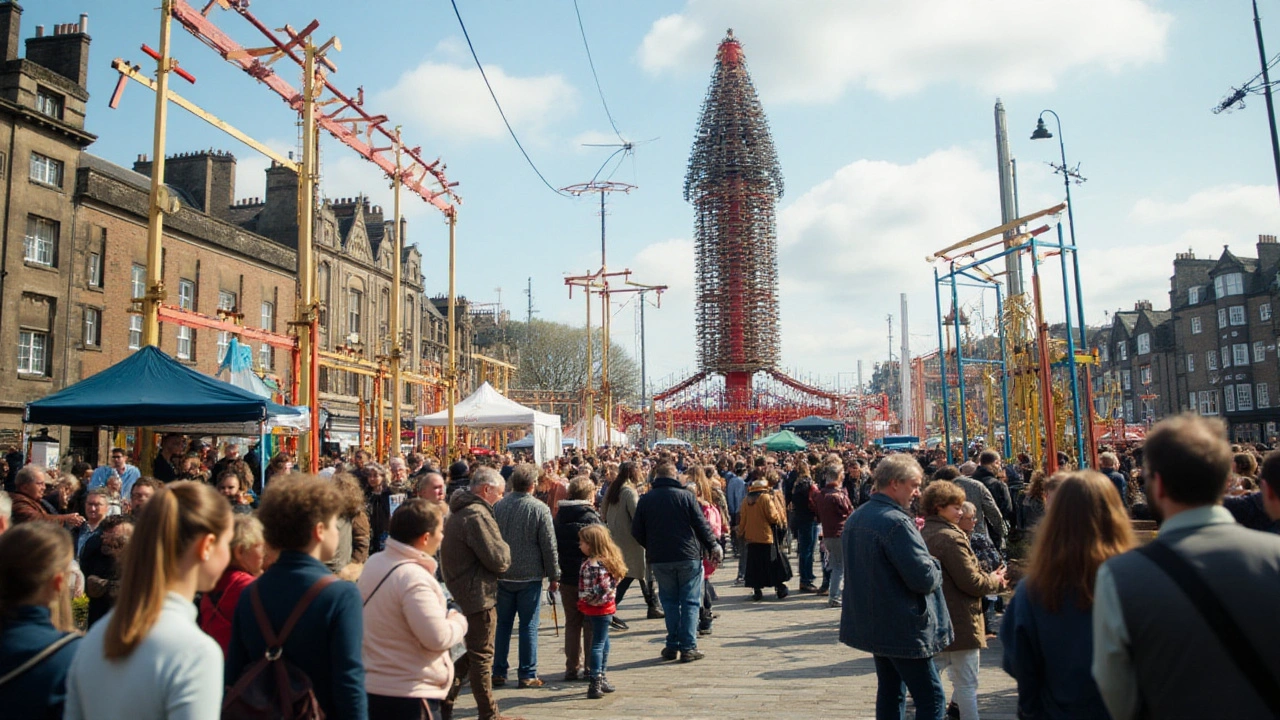
Tips for Creating Your Own Kinetic Art
Creating your very own piece of kinetic art is as thrilling as it sounds. The key to a successful project lies in merging the beauty of art with the principles of movement. Begin by acquainting yourself with the fundamental ideas that drive this art form. Start with simple designs like mobiles, which involve suspending various elements in a balanced arrangement. This is an excellent way to understand how weight, gravity, and air currents can influence your piece. Experiment with different materials—wire, metal, wood, and even recycled items can lend themselves beautifully to kinetic art when crafted thoughtfully.
One essential aspect of creating kinetic art is understanding the dynamics of movement. Getting a handle on these principles will help you construct sculptures that interact with their environment in an engaging manner. The right tools are pivotal in ensuring precision and fluidity in movement. Many artists find that crafting a smaller-scale model or prototype can serve as a helpful roadmap before diving into larger projects. During this process, trial and error is to be expected, but each iteration will bring valuable insights and innovations.
Once you've nailed the basics, consider incorporating mechanical elements. Simple gears or motors can add a captivating complexity to your kinetic sculpture. This step elevates your piece beyond rudimentary movements, introducing intricate, interactive displays that captivate viewers. Explore how these elements interact with your chosen materials. This is where physics dovetails with artistry: understanding tension, rotation, and balance is essential for designing a sculpture that can withstand the test of movement and time.
Inspiration from the Masters
You might draw inspiration from renowned artists who have left their mark in the kinetic art field. Alexander Calder, widely recognized for inventing the mobile, once said,
"To most people who look at a mobile, the underlying mathematical sense of balance is obscured; they simply see motion."His words remind us of the seamless blend of science and art that kinetic art represents. Explore exhibits, galleries, and online resources to learn how established artists tackled the challenges of motion and balance.
Once you've established a foundation, experimentation is key. Try out different mechanisms and designs, and don't shy away from mixed media. Combining more than one type of material or technique can yield unexpected and spectacular results. Document your process and learn from each step. This not only aids personal growth but also creates a portfolio of your kinetic journey that you can reflect upon and share with potential audiences. Remember, patience and persistence will be your closest allies.
The final and often overlooked tip is to seek feedback and engage with a community. Whether you're connecting online or attending local art gatherings, interaction with fellow artists provides fresh perspectives and invaluable critiques. A supportive art community can help propel your understanding of sculpture and movement forward. So, embrace the dialogue and collaboration that come with sharing your work. Who knows? Your next idea might just be sparked in a conversation with a fellow enthusiast.
With these insights and tools, you are well-equipped to embark on your journey into kinetic art. Remember, the crux of this art form lies not just in the finished piece, but in the creative process itself—a journey marked by continuous learning and adaptation.

